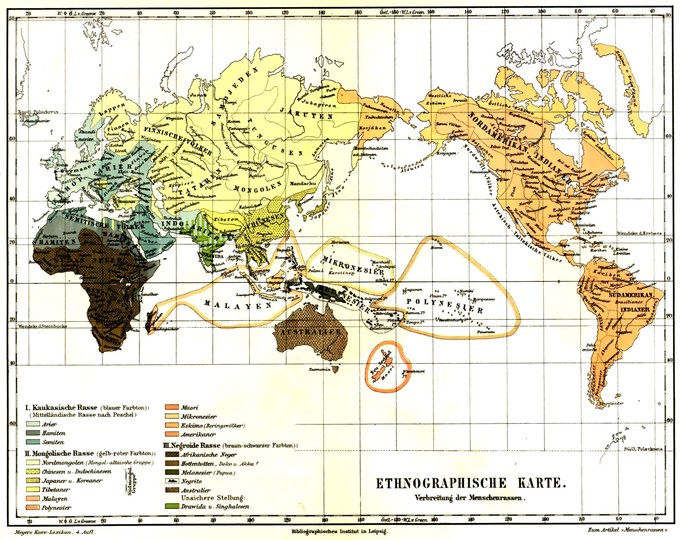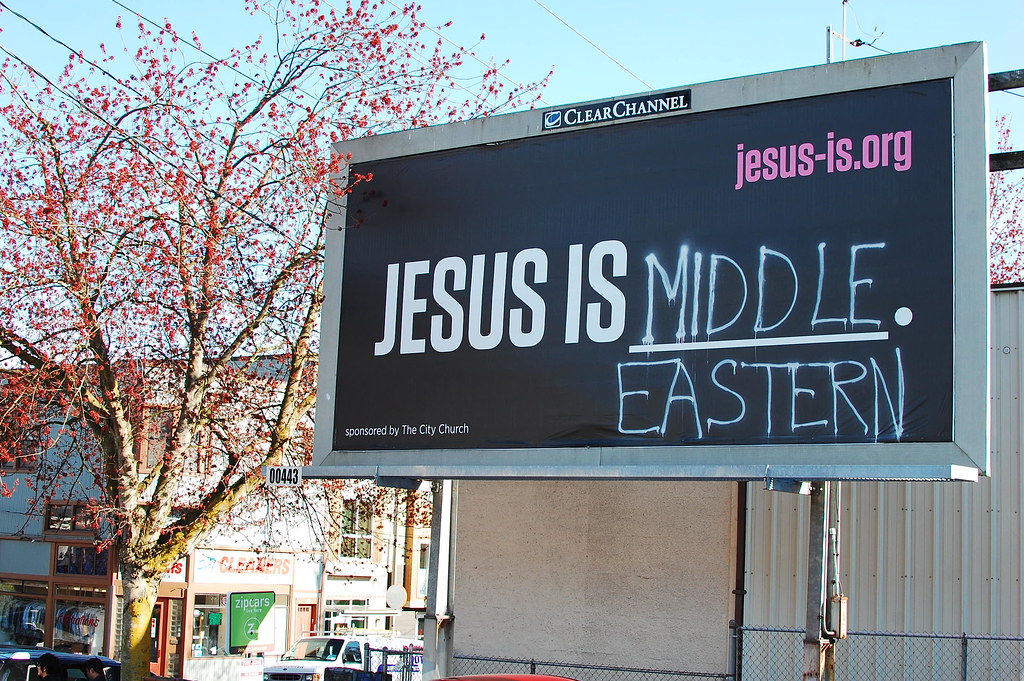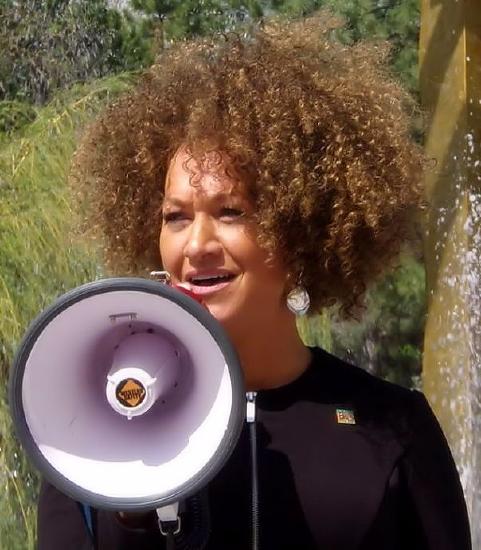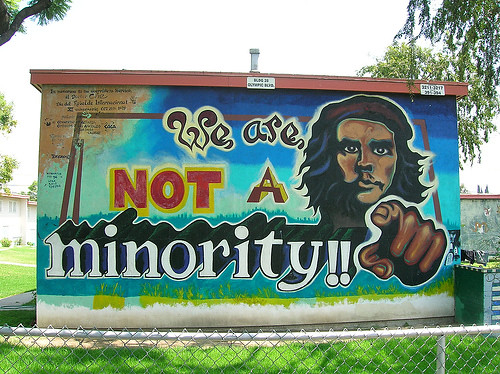1.2: Defining Race
- Last updated
- Save as PDF
- Page ID
- 45518

- Erika Gutierrez, Janét Hund, Shaheen Johnson, Carlos Ramos, Lisette Rodriguez, & Joy Tsuhako
- Long Beach City College, Cerritos College, & Saddleback College via ASCCC Open Educational Resources Initiative (OERI)
Questioning the Biological Definition of Race
From a biological perspective, race refers to a category of people who share certain inherited physical characteristics, such as skin color, facial features, and stature. Most people think of race in biological terms, and for more than 300 years, or ever since white Europeans began colonizing populations of color elsewhere in the world, race has indeed served as the “premier source of human identity” (A. Smedley, 1998, p. 690).
Phenotype and Genotype
Phenotype refers to the composite observable traits and behaviors of an individual or group. Genotype refers to a person’s genetic makeup.
Phenotype is thus the physical manifestation of genotype. The most noticeable phenotype difference is skin tone: some groups of people have very dark skin, while others have very light skin or brown skin. Other differences also exist. Some people have very curly hair, while others have very straight hair. Some individuals have thin lips, while others have thick lips. Some people tend to be relatively tall, while others tend to be relatively short. Some have oval eyes, while others have round eyes. In the past, theorists have posited categories of race based on various geographic regions, ethnicities, skin colors, and more. Their labels for racial groups have connoted regions (Mongolia and the Caucus Mountains, for instance) or skin tones (Black, white, yellow, and red, for example).

Figure \(\PageIndex{1}\): Meyers's ethnographic map, late 19th-Century. (CC PDM 1.0; Wikimedia)
An example of an early modern attempt at racial categorization, this map depicts the three great races, according to Meyers Konversationslexikon, a major encyclopedia in the German language in the late 1800s. The subtypes of the "Mongoloid" race are shown in yellow and orange tones, those of the "Europid/Caucasoid" race in light and medium grayish green-cyan tones, and those of the "Negroid" race in brown tones. Dravidians and Sinhalese are in olive green, and their classification is described as uncertain. The Mongoloid race sees the widest geographic distribution, including all of the Americas, North Asia, East Asia, Southeast Asia, and the entire inhabited Arctic.
This section licensed CC BY-SA. Attribution: Sociology (Boundless) (CC BY-SA 4.0)
It is certainly easy to see that people in the United States and around the world differ physically in some obvious ways. Race has been used as a classification system to categorize humans in a variety of ways. Using such physical differences as their criteria, scientists at one point identified as many as nine races: African, American Indian or Native American, Asian, Australian Aborigine, European (more commonly called “white”), Indian, Melanesian, Micronesian, and Polynesian (A. Smedley, 1998).
Although people certainly do differ in the many physical features that led to the development of such racial categories, anthropologists, sociologists, and many biologists question the value of these categories and thus the value of the biological concept of race (A. Smedley, 2007). For one thing, we often see more physical differences within a race than between races. For example, some people we call “white” (or European), such as those with Scandinavian backgrounds, have very light skins, while others, such as those from some Eastern European or Middle Eastern backgrounds, have much darker skins. In fact, some “whites” have darker skin than some “Blacks,” or African Americans. Some whites have very straight hair, while others have very curly hair; some have blonde hair and blue eyes, while others have dark hair and brown eyes. Because of interracial reproduction going back to the days of slavery, African Americans also differ in the darkness of their skin and in other physical characteristics. In fact it is estimated that about 80% of African Americans have some white (i.e., European) ancestry; 50% of Mexican Americans have European or Native American ancestry; and 20% of whites have African or Native American ancestry. If clear racial differences ever existed hundreds or thousands of years ago (and many scientists doubt such differences ever existed), in today’s world these differences have become increasingly blurred.
Another reason to question the biological concept of race is that an individual or a group of individuals is often “assigned” to a race based on arbitrary or even illogical grounds. A century ago, for example, Irish, Italians, and Eastern European Jews who left their homelands for a better life in the United States were not regarded as white once they reached the United States but rather as a different, inferior (if unnamed) race (Painter, 2010). The belief in their inferiority helped justify the harsh treatment they suffered in their new country. Today, of course, we call people from all three backgrounds white or European. Many individuals under the umbrella labels of Latinx or MENA (Middle East and North Africa) may also be classified as white, but that does not mean they see themselves as white. Many in these groups do not feel represented in discussions of race. As quoted by Jad Elharake, a former University of Michigan student, "A MENA category would represent a diverse set of dismissed identities with specific needs," yet the 2020 Census failed to include such a category (Alshammari, 2020).

In this context, consider someone in the United States who has a white parent and a Black parent. What race is this person? American society usually calls this person Black or African American, and the person may adopt the same identity (as does Barack Obama, who had a white mother and African father). But where is the logic for doing so? This person, including President Obama, is as much white as Black in terms of parental ancestry. Or consider someone with one white parent and another parent that is the child of one Black parent and white parent. This person thus has three white grandparents and one Black grandparent. Even though this person’s ancestry is thus 75% white and 25% Black, this person is likely to be considered Black in the United States and may well adopt this racial identity. This practice reflects the traditional “one-drop rule” in the United States that defines someone as Black if the person has at least one drop of “Black blood,” and that was used in the antebellum South to keep the enslaved African population as large as possible (Wright, 1993). Yet in many Latin American nations, this person would be considered white. In Brazil, the term Black is reserved for someone with no European (white) ancestry at all. If we followed this practice in the United States, about 80% of the people we call “Black” would now be called “white.” With such arbitrary designations, race is more of a social category than a biological one.

A third reason to question the biological concept of race comes from the field of biology itself and more specifically from the study of genetics and human evolution. Starting with genetics, people from different races are more than 99.9% the same in their DNA (Begley, 2008). To turn that around, less than 0.1% of all the DNA in our bodies accounts for the physical differences among people that we associate with racial differences. In terms of DNA or genotype, then, people with different racial backgrounds are much more similar than dissimilar. In a December, 2003, Scientific American article, Bamshad and Olson, two geneticists working on mapping the human genome, concluded that “race” does not exist genetically.
According to evolutionary theory, the human race began thousands and thousands of years ago in sub-Saharan Africa. As people migrated around the world over the millennia, natural selection took over. It favored dark skin for people living in hot, sunny climates (i.e., near the equator), because the heavy amounts of melanin that produce dark skin protect against severe sunburn, cancer, and other problems. By the same token, natural selection favored light skin for people who migrated farther from the equator to cooler, less sunny climates, because dark skin there would have interfered with the production of vitamin D (Stone & Lurquin, 2007). Evidence shows physical differences in human appearance including skin color are a result of human migration patterns and adaptations to the environment (Jablonski, 2012). Evolutionary evidence thus reinforces the common humanity of people who differ in the rather superficial ways associated with their appearances: we are one human species, homo sapiens sapiens, composed of people who happen to look different. Nonetheless, people use physical characteristics to identify, relate, and interact with one another.
Thinking Sociologically
Global Census: What race would you be somewhere else?
Visit Global Census: What race would you be somewhere else? to help you understand how race is classified differently depending on the country, and some countries measure ethnicity (discussed next in Chapter 1.3) rather than race in their Census.
What racial group do others identify you as? What racial group do you identify yourself? Is there a difference in how you identify yourself versus how others identify you?
Do you think it is important for a country to measure race (or ethnicity) of its population? Why or why not?
Race as a Social Construct
The reasons for doubting the biological basis for racial categories suggest that race is more of a social category than a biological one. Another way to say this is that race is a social construction, a concept that has no objective reality but rather is what people decide it is (Berger & Luckmann, 1963). In this view race has no real existence other than what and how people think of it; what matters is the social meaning attached to race.

Although race is a social construction, it is also true that things perceived as real are real in their consequences. Because people do perceive race as something real, it has real consequences. Even though so little of DNA accounts for the physical differences we associate with racial differences, that low amount leads us not only to classify people into different races but to treat them differently—and, more to the point, unequally—based on their classification. Yet modern evidence shows there is little, if any, scientific basis for the racial classification that is the source of so much inequality.
Social science organizations including the American Association of Anthropologists, the American Sociological Association, and the American Psychological Association have all taken an official position rejecting the biological explanations of race. Over time, the typology of race that developed during early racialized science has fallen into disuse, and the social construction of race is a more sociological way of understanding racial categories. In Race as Biology is Fiction, Racism as a Social Problem is Real, Smedley & Smedley (2005) wrote that "racialized science, with its emphasis on identifying immutable differences between racial groups, can be expected only to maintain and reinforce existing racial inequality, in that its adherents indirectly argue that no degree of government intervention or social change will alter the skills and abilities of different racial groups." Research in this school of thought suggests that race is not biologically identifiable and that previous racial categories were arbitrarily assigned, based on pseudo science, and used to justify racist practices (Omi & Winant, 1994; Graves, 2003). From the 17th through the 19th centuries, the merging of folk beliefs about and scientific explanations of group differences produced what social anthropologist Audrey Smedley has called an “ideology of race" which, often in the name of (racialized) science, serves to justify the racial hierarchy and racial hegemony. "Race is a means of creating and enforcing social order, a lens through which differential opportunity and inequality are structured" (Smedley & Smedley, 2005). Further, they argue that the most important "criterion of status" remains to be the distinction between white and Black.
According to historian Milton Meltzer, the rise of the transatlantic slave trade created an incentive to categorize human groups in order to justify the subordination of Africans as slaves. As Europeans began to sort themselves and others into groups based on physical appearance, they attributed to individual members of these groups certain behaviors and capacities that were supposedly deeply ingrained. These supposed physical, intellectual, behavioral, and moral differences soon became part of common folk belief.
During the time of slavery in the U.S. South, the skin tone of enslaved peoples lightened over the years as babies were born from the union, often in the form of rape of enslaved individuals, by slave owners and other whites. As it became difficult to tell who was “Black” and who was not, many court battles over people’s racial identity occurred. People who were accused of having Black ancestry would go to court to “prove” they were white in order to avoid enslavement or other problems (Staples, 1998). Litigation over race continued long past the days of slavery. In a relatively recent example, Susie Guillory Phipps sued the Louisiana Bureau of Vital Records in the early 1980s to change her “official” race to white. Phipps was descended from a slave owner and a slave; thereafter, her other ancestors were white. Despite this fact, she was called “Black” on her birth certificate because of a state law, echoing the “one-drop rule,” that designated people as Black if their ancestry was at least 1/32 Black (meaning one of their great-great-great grandparents was Black). Phipps had always thought of herself as white and was surprised after seeing a copy of her birth certificate to discover she was officially Black because she had one African ancestor about 150 years earlier. She lost her case, and the U.S. Supreme Court later refused to review it (Omi & Winant, 1994).
Relatedly, the tradition of hostility between the English and the Irish was a powerful influence on early European thinking of the Irish as an inferior “race.” The atrocities committed against the Irish by the English veterans of the war in Ireland in the early 1600s would be repeated against American Indians/Alaska Natives (AI/AN) (Takaki, 2008). Both AI/AN and Mexican Americans lost their land, and often their lives, due in part to Manifest Destiny, the Mexican American War, and whites' belief in their god-given (superiority and) right to inhabit (and steal) lands in which people were already living. As will be discussed further in Chapter 6.1, Irish Americans were treated similar to African Americans during the 1800s; it was not until they "became white" that the stigma of their Irish ancestry would be erased and they would gain access to property, power and privilege, similar to other whites.
Following World War II, alongside empirical and conceptual problems with “race,” evolutionary and social scientists were acutely aware of how beliefs about race had been used to justify discrimination, apartheid, slavery, and genocide. This questioning gained momentum in the 1960s during the U.S. civil rights movement and the emergence of numerous anti-colonial movements worldwide. The social construction of race has developed within various legal, economic, and sociopolitical contexts, and may be the effect, rather than the cause of major race-related issues. Race has real, material effects in housing discrimination, in the legal process, in policing practices, in education, in workplace discrimination, and many other domains of society characterized by institutionalized practices of preference and systemic oppression. As a result, racial groups possessing relatively little power often find themselves excluded or oppressed. Law enforcement officers often utilize race to profile suspects, a term commonly referred to as racial profiling. This use of racial categories is frequently criticized for perpetuating an outmoded understanding of human biological variation, and promoting stereotypes.
Racial Formation
Sociologists Omi and Winant’s theories of racial formation describes race development as a socio-historical process involving political struggle and that “race is a concept which signifies and symbolizes social conflicts and interests by referring to different types of human bodies" (Omi & Winant, 1994).
This section licensed CC BY-SA. Attribution: Sociology (Boundless) (CC BY-SA 4.0)
Socioeconomic factors, in combination with early but enduring views of race, have led to considerable suffering within disadvantaged racial groups. Racial discrimination often coincides with racist mindsets, whereby the individuals and ideologies of one group come to perceive the members of outgroups as both racially defined and morally inferior. Such practices illuminate how far-removed modern understanding of race is from biological qualities. In modern society, some people who consider themselves “white” actually have more melanin (a pigment that determines skin color) in their skin than other people who identify as ”Black.” Consider the case of the actress Rashida Jones. She is the daughter of a Black man (Quincy Jones) and a white woman, and her best-known roles include Ann Perkins on Parks and Recreation, Karen Filippelli on The Office, and Zooey Rice in I Love You Man, none of whom are Black characters. In some countries, such as Brazil, class is more important than skin color in determining racial categorization. People with high levels of melanin may consider themselves "white" if they enjoy a middle-class lifestyle. On the other hand, someone with low levels of melanin might be assigned the identity of "Black" if he or she has little education or money.
The social construction of race is also reflected in the changing labels for racial categories; these labels change with the times. It’s worth noting that race, in this sense, is also a system of labeling that provides a source of identity; specific labels fall in and out of favor during different social eras. For example, the category ”negroid,” popular in the nineteenth century, evolved into the term “negro” by the 1960s, which shifted to Black as a result of the Black Power and Black Nationalist movements declaring "Black is Beautiful," and in contemporary times “African American” may also be used. This term was intended to celebrate the multiple identities that a Black person might hold, but this word choice is not without its problems: it lumps together a large variety of ethnic groups under an umbrella term while excluding others who could accurately be described by the label but who do not meet the spirit of the term. For example, actress Charlize Theron is a blonde-haired, blue-eyed “African American.” She was born in South Africa and later became a U.S. citizen. Is her identity that of an “African American” as most of us understand the term? Further, many Black Americans do not have knowledge of African cultural roots and thus may reject the label of African American. In Chapter 1.4, more discussion is provided on the changing U.S. Census categories for race.


Aside from labels, a society's conceptualization of beauty is also intertwined with race, racism, and colorism, as light skin phenotype is often correlated with beauty within the dominant society and social institution of mass media. According to the research of Eugenia Kaw, Asian American Pacific Islander (AAPI) women's decision to undergo cosmetic surgery is an attempt to escape persisting racial prejudice that correlates their stereotyped genetic physical features (“small, slanty” eyes and a “flat” nose) with negative behavioral characteristics, such as passivity, dullness, and a lack of sociability. When AAPI women elect for cosmetic surgery, it is more often double eyelid, sculpted nose or breast enlargement. The women in Kaw's study indicated that they chose their surgeries to improve their social status, and to gain “symbolic capital,” thus prestige. “(The medical establishment and U.S. culture) are able to motivate women to view their feelings of inadequacy as individually motivated, as opposed to socially induced, phenomena, thereby effectively convincing them to participate in the production and reproduction of the larger structural inequalities that continue to oppress them” (Kaw, 1993).
Racialization
Sociologists also use the term racialization which refers to the processes by which a group of people is defined by their “race.” Processes of racialization begin by attributing racial meaning to people's identity and, in particular, as they relate to our institutional systems, such as housing, employment, mass media, and education. In societies in which white people have economic, political, and social power, processes of racialization have emerged from the concept of a racial hierarchy in these social systems. The visible effects of racialization are the resulting racial inequalities such as police brutality, substandard housing, and under-funded education. To be racialized is to be oppressed and imposed upon by the dominant group.
The exploitation, control and exclusion associated with racialization leads to people being singled out for unique treatment on the basis of real or imagined physical characteristics. Hence, racialized peoples are assigned racial categories leading to stigmatization and marginalization. While a stigma is a mark of disgrace, to be marginal is to be denied full access to social, political, economic, and cultural power and social institutions.
Various racialized caricatures can be found in mass media such as Black Face or Yellow Face characters prevalent in the last century. African American men have been portrayed as criminal or violent, while African American women have been portrayed as sassy or aggressive. The Latinx population has been racialized by their sex appeal, Latinas as spicy and Latinos as the Latin Lover. Racialization of the Latinx population is further discussed in Chapter 8.5. Conversely, Asian American men are regarded on the big screen as having no sex appeal, while Asian American women have been portrayed as sex slaves. Consistent images of American Indians/Alaska Natives equate with the portrayal as "savages" or lacking human qualities.
Minority Group & Dominant Group
Whereas racialization is an active process engaged in by society, the use of minority and dominant groups is more passive labeling. Sociologist Louis Wirth (1945) defined a minority group as “any group of people who, because of their physical or cultural characteristics, are singled out from the others in the society resulting in differential and unequal treatment, and who therefore regard themselves as objects of collective discrimination.” Minority group status can be based on social categories such as age, gender, sexuality, race and ethnicity, religious beliefs, disability or socioeconomic class status. Minority groups are not necessarily numerical minorities (Griffiths, Keirns, Strayer, Cody-Rydzewsk, Scaramuzzo, Sadler, Vyain, Byer & Jones, 2015). For example, a large group of people may be a people of color because they lack social power. In fact, the South African system of apartheid (a system of de jure discrimination) was a major indicator that a people of color is socially and not numerically defined, as 90% of the population of South Africa is Black but until the very early 1990s they were the people of color and the 10% of the population who are white were the dominant group. The physical and cultural traits of people of colors “are held in low esteem by the dominant or majority group which treats them unfairly” (Henslin, 2011, p. 217).
According to Charles Wagley and Marvin Harris (1958), a people of color is distinguished by five characteristics: (1) unequal treatment and less power over their lives, (2) distinguishing physical or cultural traits like skin color or language, (3) involuntary membership in the group, (4) awareness of subordination, and (5) high rate of in-group marriage. In addition to communities of color, additional examples of people of colors might include the LBGTQ+ group, religious practitioners whose faith is not widely practiced where they live, and people with disabilities.
The dominant group has greater power, prestige, property (wealth), and status in society and receives greater, automatic privileges. As a result, the dominant group uses its position to discriminate against those that are different. Historically known as WASP (white Anglo Saxon Protestant), the dominant group in the United States is represented by white, middle-class, Protestant people of northern European descent (Doane, 2016). A dominant group is positively privileged (Weber,1978), unstigmatized (Rosenblum & Travis, 2011) and generally favored by the institutions of society, (Marger, 1996) particularly the social, economic, political, and educational systems.
Minority groups can garner power by expanding political boundaries or through expanded migration, though both of these efforts do not occur with ease and require societal support from both communities of color and dominant group members. The loss of power among dominant groups threatens not only their authority over other groups, but also the privileges and way of life established by the dominant group. In Chapter 6.3, white privilege and challenges to white supremacy are discussed.
As there is some controversy with using the concept of people of color, due to the often inferior and pejorative connotation with this label, efforts are made throughout this book to use the concepts, people of color or communities of color. The use of these concepts seeks to call attention to the commonalities of experience that Black or African Americans, American Indian/Alaska Natives (AI/AN), Latinx, and Asian American Pacific Islanders (AAPI) share - though as ensuing chapters will also show, the groups have their own distinct history and contemporary experiences.

Conclusion
David K. Shipler (1997) felt compelled to observe that there is “no more intractable, pervasive issue than race” and that when it comes to race, we are “a country of strangers.” Sociologists and other social scientists have warned that the conditions of people of color have actually been worsening (Massey, 2007; Wilson, 2009). Despite the historic election of Barack Obama in 2008 as the first president of color, race remains an “intractable, pervasive issue.” As the old French saying goes, plus ça change, plus la meme chose (the more things change, the more they stay the same). Indeed, it would be accurate to catapult back to Du Bois and thus paraphrase him, that “the problem of the 21st century is the problem of the color line.” Evidence of this continuing problem appears in much of the remainder of this chapter and text.
Debates continue in and among academic disciplines as to how race should be understood. Most social scientists and biologists believe race is a social construct, meaning it does not have a basis in the natural world but is simply an artificial distinction created by humans. As a result of this understanding, some researchers have turned from conceptualizing and analyzing human variation by race to doing so in terms of populations, dismissing racial classifications altogether. In the face of the increasing rejection of race as a valid classification scheme, many social scientists have replaced the word race with the word “ethnicity” to refer to self-identifying groups based on shared religion, nationality, or culture.
Key Takeaways
- Race has a biological component (e.g. phenotype and genotype) resulting in classification systems of different racial groups, depending on the time period and geographical location.
- Sociologists question the consideration of race as a biological categorization due to the social construction of race and the fact that human beings have far more biological similarities than differences.
- Racial ideology, racial formation, racialization, and racialized science are concepts that help to understand that race is important in this society due to its social meaning which is marked by struggle, division, and hierarchy.
- Various labels (e.g. minority group, dominant group, marginalized group, people of color, and communities of color) are used to identify racial groups.
Contributors and Attributions
Content on this page has multiple licenses. Everything is CC BY-NC-SA other than Phenotype & Genotype and Racial Formation which are CC BY-SA.
- Hund, Janét. (Long Beach City College)
- Rodriguez, Lisette. (Long Beach City College)
- Sociology (Barkan) (CC BY-NC-SA 4.0)
- Sociology (Boundless) (CC BY-SA 4.0) (Contributed to Phenotype & Genotype and Racial Formation)
- Minority Studies (Dunn) (CC BY 4.0)
- A Career in Sociology (Kennedy) (CC BY-NC-SA 4.0)
- Introduction to Sociology 2e (OpenStax) (CC BY 4.0)
Works Cited
- Alshammari, Y. (2020, April 1). Why is there no MENA category on the 2020 US census? Aljazeera.
- Bamshad, M. & Olson, S. (2003). Does race exist? Scientific American. 289(6), 78-85.
- Begley, S. (2008, February 29). Race and DNA. Newsweek.
- Berger, P. & Luckmann, T. (1963). The Social Construction of Reality. New York, NY: Doubleday.
- Doane, A.W. (2016). Dominant group ethnic identity in the United States: The role of ‘hidden’ ethnicity in intergroup relations. The Sociological Quarterly. 38(3), 375-397.
- Griffiths, H., Keirns, N., Strayer, E., Cody-Rydzewsk, S., Scaramuzzo, G., Sadler, T., Vyain, S., Byer, J. & Jones, F. (2015). Introduction to Sociology. 2nd ed. Houston, TX: OpenStax College.
- Henslin, J. M. (2011). Essentials of Sociology: A Down-to-Earth Approach. 11th ed. Upper Saddle River, NJ: Pearson.
- Jablonski, N. (2012). Living Color: The Biological and Social Meaning of Skin Color. Berkeley, CA: University of California Press.
- Kaw, E. (1993). Medicalization of racial features: Asian American women and cosmetic surgery. University of California.
- Kottak, C.P. & Kozaitis, K.A. (2012). On Being Different: Diversity and Multiculturalism in the North American Mainstream. 4th ed. New York: McGraw-Hill College.
- Marger, M. (1996). Race and Ethnic Relations: American and Global Perspectives. 4th ed. Belmont, CA: Wadsworth.
- Massey, D. (2007). Categorically Unequal: The American Stratification System. New York, NY: Russell Sage Foundation.
- Meyers Konversationslexikon. 4th edition. (1885-92).
- Omi, M. and Winant, H. (1994). Racial Formation in the United States: From the 1960s to the 1990s. 2nd ed. New York, NY: Routledge.
- Painter, N.I. (2010). The History of white People. New York, NY: W. W. Norton.
- Rosenblum, K. & Travis, T. (2011). The Meaning of Difference: American Constructions of Race, Sex and Gender, Social Class, Sexual Orientation, and Disability. 6th edition. New York, NY: McGraw-Hill.
- Shipler, D.K. (1997). A Country of Strangers: Blacks and whites in America. New York, NY: Alfred A. Knopf.
- Smedley, A. & Smedley, B. (2005). Race as biology is fiction, racism as a social problem is real. The American Psychologist, 60(1), 16-26.
- Smedley, A. (1998). “Race” and the construction of human identity. American Anthropologist, 100, 690–702.
- Smedley, A. (2007). Race in North America: Evolution of a worldview. Boulder, CO: Westview Press..
- Staples, B. (1998, November 13). The shifting meanings of “Black” and “white.” The New York Times.
- Stone, L. & Lurquin, P.F. (2007). Genes, Culture, and Human Evolution: A Synthesis. Malden, MA: Blackwell.
- Takaki, R. (2008). A Different Mirror: A History of Multicultural America. New York, NY: Back Bay Books/Little Brown & Company.
- Wagley, C. & Harris. (1958). Minorities in the New World. New York, NY: Columbia University Press.
- Weber, M. (1978) [1968]. Economy and Society. Berkeley, CA: University of California Press.
- Wilson, W.J. (2009, May/June). More than just race: Being Black and poor in the inner city. Poverty and Race Research Action Council.
- Wirth, L. (1945). The problem of people of colors. In The Science of Man in the World Crisis, (R. Linton Ed.), New York, NY: Columbia University Press.
- Wright, L. (1993, July 12). One drop of blood. The New Yorker, pp. 46–54.

